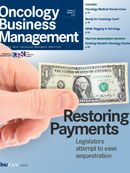Publication
Article
Oncology Business News®
Addressing the Growing Need for Geriatric Oncology
Author(s):
Researchers at Thomas Jefferson University's Kimmel Cancer Center in Philadelphia have developed a model for establishing a comprehensive multidisciplinary geriatric oncology center to avoid the potential overtreatment or undertreatment that elderly patients with cancer may face.
Andrew E. Chapman, DO
Researchers at Thomas Jefferson University’s Kimmel Cancer Center in Philadelphia have developed a model for establishing a comprehensive multidisciplinary geriatric oncology center to avoid the potential overtreatment or undertreatment that elderly patients with cancer may face. The model is aimed towards both newly diagnosed and established patients 70 years of age and over.
“The demographics are so dramatic in terms of the incidence of cancer in the aging population. There’s going to be an ever growing need for geriatric oncology as a field in the near future,” said Andrew E. Chapman, DO, clinical associate professor of Medicine at Thomas Jefferson University, and co-director of the Jefferson Senior Adult Oncology Center.
A model for delivering care to elderly patients is important, especially because the US population over the age of 65 years is expected to double by 2030, and because the cancer incidence is 11-fold higher in this age group. About 60% of all cancers and 70% of all cancer mortalities occur in people over 65 years of age.1 Chapman is participating in a workshop addressing this topic, entitled “Existing Geriatric Oncology Models: Opportunities and Barriers—Oncologist-Centered Models,” during ASCO’s 50th Annual Meeting in Chicago, Illinois.
“We built a multidisciplinary evaluation center that would be primarily consultative—where the patients would be referred to us, we conduct an intensive evaluation, and then we feed that information back to the referring physician,” Chapman explained in describing the model.
This type of evaluation is meant to augment the discussion a medical oncologist might have with his patient. “In no way are we trying to infringe on what they’re doing. We’re not trying to take work away from them, we’re trying to add information to help them further individualize the care they provide to their patients,” Chapman emphasized.
According to this model of care, professionals in medical oncology, geriatric medicine, pharmacy, social work, and nutrition evaluate patients during a 2-hour visit. After the visit, the interprofessional team meets to review each case and formulate a comprehensive treatment plan. Then, the patient is classified as fit, vulnerable, or frail, based on the Comprehensive Geriatric Assessment (CGA).
The CGA is an important tool that can be used to further right-size, or individualize, the care to better meet the patient’s goals. However, formulating the best model for a CGA has yet to be determined. Current models involve a frailty screening, followed by referral for additional assessment if the patient is determined to be vulnerable or frail.
Chapman and colleagues identified several challenges in developing the clinic, including patient-related issues, navigation, financial reimbursement, referral patterns, and coordination of care during office hours.
A total of 211 patients were initially treated when the Thomas Jefferson unit opened. The average age of the patient seen was 80.7 years and the most common diagnoses were breast, colorectal, and lung cancers. Twenty-four percent of patients were determined to be fit, 47% were deemed vulnerable, and 29% were considered frail.
The senior adult cancer center is housed within the Kimmel Cancer Center. It is patient-centered, meaning that once a senior is situated in an examination room with his caregivers, the multidisciplinary care specialists rotate in and out, so the patient does not have to move from room to room. Office hours are adapted to better accommodate the patients’, and their caregivers’, schedule. In addition, helping patients navigate the health care system to make appointments, obtain records, and confirm locations has led to high compliance and satisfaction for the patient and family members, according to Chapman.
Next steps for the center include the development of a clinical trials program and the continuing training of fellows in both medical oncology and geriatrics to enable dually boarded, fully certified geriatric oncologists.
Reference
- Yanick R. Cancer burden in the aged: an epidemiologic and demographic overview. Cancer—Am Cancer Soc. 1996;80:1273- 1283.
Source
Chapman AE, Swartz K, Schoppe J, Arenson C. Development of a comprehensive multidisciplinary geriatric oncology center, the Thomas Jefferson University experience. J Ger Oncol. 2014; 5:164-170.










